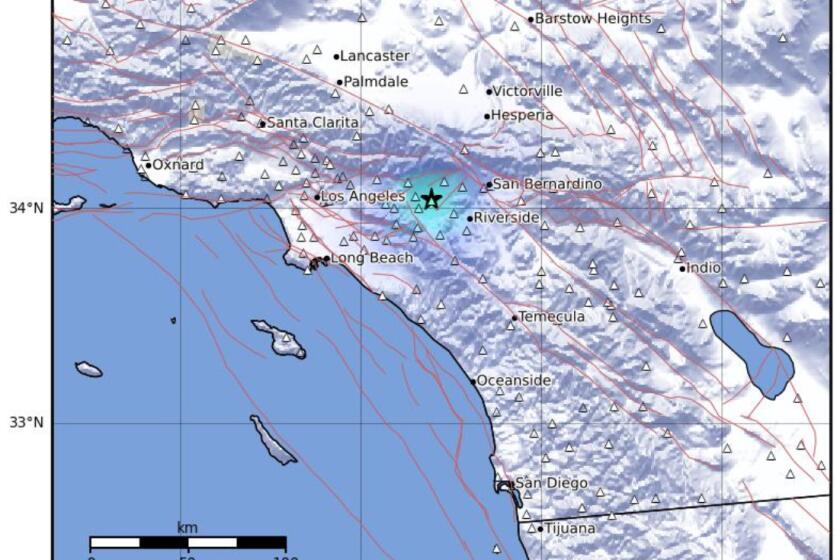AMERICAN GEOPHYSICAL UNION MEETING : Scientists Report Threat of California Tidal Waves
SAN FRANCISCO — Last April’s magnitude 7.1 Humboldt County earthquake gave rise to small tsunamis in California and as far as Alaska and Hawaii, the only recorded tidal waves generated by a California quake in this century, according to scientists from the National Oceanic and Atmospheric Administration.
The waves, which have not been reported until now, have been the subject of considerable study since the quake. Scientists gathered here for the annual meeting of the American Geophysical Union say the observations suggest that tidal waves could be a bigger hazard of offshore California quakes than had been previously thought.
Crescent City received two waves, one at 40 minutes after the temblor’s main shock, and a second two hours later, causing water to rise to about 20 inches above normal, the scientists said. The waves caused no damage because it was low tide at the time.
Abnormal wave action continued at Crescent City for eight hours after the quake, pointing up the tendency of tsunamis to move outward in well-spaced concentric waves, as when a rock is thrown into a pond. Sometimes, later waves are higher than the first one.
Edward N. Bernard, director of the NOAA’s Pacific Marine Environmental Laboratory in Seattle, said that recording instruments also measured minor tsunamis in the Aleutian Islands, the Hawaiian Islands and even beyond Hawaii, at Johnston Island.
The first waves took about four hours to reach Alaska and 5 1/2 hours to reach Hawaii. On Maui, the topmost wave measured a little over four inches higher than the tides at that hour would normally dictate.
Instruments also measured a very small abnormality in wave action as far down the California coast as Santa Barbara, Bernard said.
Lori Dengler, a seismologist at Humboldt State University, noted that the first wave took only 20 minutes to reach Eureka, about 40 miles north of the quake’s epicenter, the morning of April 25.
“Tsunamis could, under certain circumstances, be the principal hazard from an earthquake off the North Coast, and the warning time might not be very long; that’s the message that has to be gotten out there,” she said.
Coincidentally, there was a presentation at the meeting on the tsunamis last September that inundated the west coast of Nicaragua with waves more than 30 feet high, causing about 170 deaths and more than 400 injuries.
Researchers who had interviewed survivors said the quake causing the waves was centered about 60 miles offshore and they were told it was felt only as light shaking on the coast. The devastating waves that struck a short time later came as a total surprise.
Bernard said the Humboldt County quake was centered slightly onshore, but caused some ground deformation offshore, generating the tsunamis. Had the quake been centered farther offshore in deeper water, the waves could easily have been much larger, he said.
Ten people were killed and 35 injured at Crescent City in 1964 when the port was struck by a tsunami generated by the Alaska earthquake that severely damaged Anchorage.
Bernard said NOAA believes there are three lessons to be drawn from last spring’s events:
* “Tsunamis are rapid. . . . Nearby coastal communities have little or no time before the arrival of the first wave” and should be evacuated as soon as a quake is felt.
* “Tsunami hazards are of relatively long duration (due to repeated waves). . . . Effective hazard management must therefore ensure that citizens do not return before the danger is past and that basic necessities are provided for comfort and safety during an extended evacuation period.”
* “The southern end of the Cascadia Subduction Zone generated (the Humboldt County earthquake). Many geophysicists believe this zone is capable of producing a much stronger earthquake, almost certainly accompanied by a large and destructive tsunami.”
A subduction zone is an area where one tectonic plate floating on the Earth’s mantle is diving and pushing another upward. In this case, the Gorda plate is pushing the North American plate, and this is believed to be related to the periodic volcanic activity in the Cascade range, from British Columbia to Northern California.
Bernard said that research into sand deposits on the Washington coast, along the subduction zone, suggests that major tidal waves hit Puget Sound, Wash., about 300 and 1,200 years ago.
David Oppenheimer of the U.S. Geological Survey observed that last April’s earthquake “demonstrates that seismicity in the Cascadia Subduction Zone can certainly affect the area all the way south to Cape Mendocino in Northern California.”
More to Read
Sign up for Essential California
The most important California stories and recommendations in your inbox every morning.
You may occasionally receive promotional content from the Los Angeles Times.










